The Benefits of a Service Management Platform
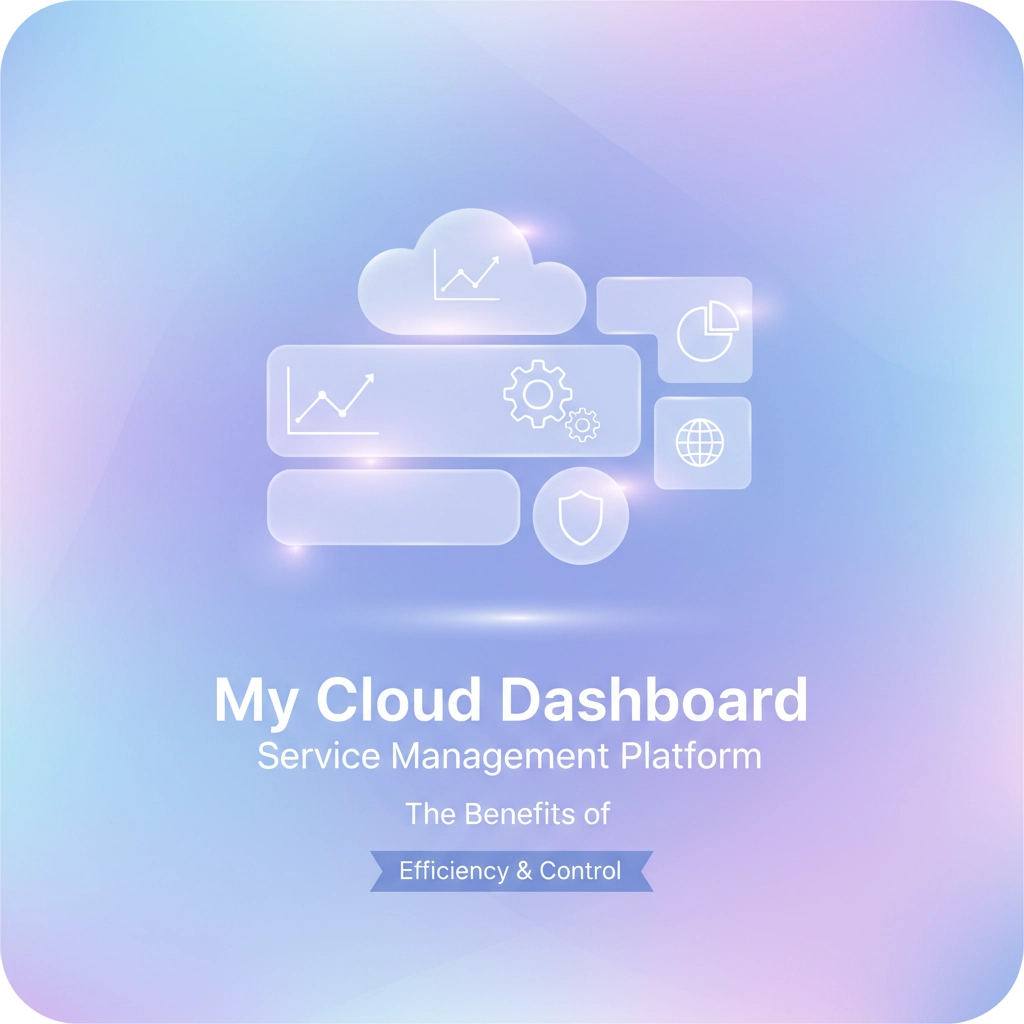
The Benefits of My Cloud Dashboard as a Service Management Platform Running a service-based business shouldn’t feel like you’re drowning in paperwork, juggling phone calls, and constantly playing catch-up with your field team. If you’re tired of spending more time on admin tasks than actually serving customers, you’re not alone. Most small to medium service businesses struggle with the same challenges: scattered information, manual scheduling headaches, and teams that feel disconnected from the office.That’s where My Cloud Dashboard changes everything. Built specifically for service businesses like yours, our platform transforms how you manage field operations, turning chaos into streamlined efficiency that actually saves you time and money. Stop Wasting Hours on Administrative Tasks Your time is valuable, and every minute spent on repetitive admin work is a minute stolen from growing your business. My Cloud Dashboard eliminates the endless cycle of manual data entry, phone tag with customers, and chasing down paperwork from your field team.Our automated workflows handle the boring stuff for you: generating professional invoices after job completion, sending payment reminders for overdue accounts, and following up with customers automatically. Instead of spending your evenings catching up on invoicing, you can focus on what really matters: delivering exceptional service and growing your business. The platform also centralizes all your customer communications in one place. No more digging through email chains or sticky notes to find that important detail about Mrs. Johnson’s gate code or the special instructions for the Henderson account. Everything your team needs is right there, accessible from any device. Transform Your Scheduling from Nightmare to Breeze If you’ve ever tried to coordinate multiple field technicians across different job sites while dealing with last-minute cancellations and emergency calls, you know scheduling can be your biggest daily headache. My Cloud Dashboard’s smart scheduling features turn this chaos into organized efficiency.The system automatically generates optimal routes for your field staff, reducing travel time and fuel costs while maximizing the number of jobs they can complete each day. When traffic delays or emergency calls disrupt your perfectly planned day, real-time updates allow instant schedule adjustments without the usual panic and confusion.Your team receives automatic notifications about schedule changes, complete job details, and customer information directly on their mobile devices. No more frantic phone calls asking “What’s the address again?” or “Did you remember to tell them about the special pricing?” Keep Your Field Team Connected and Productive Your field technicians are the face of your business, but traditional management systems leave them feeling isolated and uninformed. My Cloud Dashboard bridges this gap with a powerful mobile app that keeps everyone connected and informed. Field staff can access complete job cards with all work requirements, view customer history and special notes, upload photos for documentation, and update job status in real-time. The built-in GPS navigation ensures they always reach the right location, while the ability to capture digital signatures and process payments on-site speeds up job completion and improves cash flow.When your technicians feel empowered with the right information and tools, they deliver better service, complete jobs more efficiently, and represent your business professionally. This translates directly into happier customers and more referrals. Get Real-Time Visibility Into Your Operations Running a service business often feels like flying blind: you send your team out in the morning and hope everything goes smoothly. My Cloud Dashboard gives you complete visibility into your operations with real-time updates and comprehensive reporting.Track job progress as it happens, monitor your team’s location and status, and receive instant notifications about completed work or issues that need attention. This real-time visibility allows you to proactively address problems before they escalate and keep customers informed about service progress.The platform’s reporting features help you identify trends, track performance metrics, and make data-driven decisions about your business. Discover which services are most profitable, identify your most efficient technicians, and spot opportunities for operational improvements. Streamline Customer Relationships and Communication Managing customer relationships manually through spreadsheets and scattered notes is a recipe for missed opportunities and frustrated clients. My Cloud Dashboard’s integrated CRM system organizes all customer information in one accessible location, ensuring you never lose track of important details. Store customer preferences, service history, pricing agreements, and communication logs in organized profiles that your entire team can access. This consistency means every interaction with your customers feels personal and professional, whether they’re talking to you, your dispatcher, or your field technician.Automated communication features keep customers informed throughout the service process: booking confirmations, technician arrival notifications, and follow-up surveys all happen automatically. This level of communication builds trust and sets you apart from competitors who leave customers guessing about service status. Simplify Financial Management and Improve Cash Flow Cash flow challenges plague many service businesses, often because of slow invoicing processes and difficulty tracking payments. My Cloud Dashboard streamlines your entire financial workflow from quote to payment.Generate professional quotes quickly using stored pricing information and service templates. Once work is approved, the job automatically flows into scheduling and dispatch. Upon completion, invoices are generated automatically and can be sent immediately to customers.The platform integrates with popular payment processors, allowing customers to pay online easily and speeding up your cash collection. For recurring services, automated billing ensures consistent revenue without manual intervention. You’ll spend less time chasing payments and more time focusing on service delivery. Scale Your Business Without Adding Complexity Many service businesses hit growth plateaus not because of lack of demand, but because their operational systems can’t handle increased volume. My Cloud Dashboard is built to scale with your business, supporting growth without adding complexity or overwhelming your team.As you add more technicians, expand service areas, or introduce new service lines, the platform adapts seamlessly. Advanced features like territory management, multi-location support, and role-based permissions ensure your growing team stays organized and efficient. The system’s automation capabilities become even more valuable as you scale: what might save you a few hours per week as a small operation can save dozens of hours monthly as you grow. Experience the My Cloud
Field Service Scheduling Software: 7 Mistakes You’re Making (

Field Service Scheduling Software: 7 Mistakes You’re Making (and How to Fix Them) Field service scheduling can make or break your business operations. While the right software transforms productivity and customer satisfaction, common mistakes can drain resources and damage your reputation. You’re likely making at least one of these critical errors that’s costing you time, money, and customers.Let’s dive into the seven most damaging field service scheduling mistakes and discover how to fix them before they impact your bottom line. Mistake #1: Sending Technicians Without Remote Troubleshooting First Your biggest scheduling mistake might happen before you even create a work order. When service requests come in, many companies immediately dispatch technicians without attempting remote troubleshooting first. This knee-jerk reaction wastes valuable resources and creates unnecessary costs.Smart dispatchers review asset history and service records before scheduling field visits. Remote engineering teams can often resolve issues through phone guidance, remote diagnostics, or simple customer instructions. When remote troubleshooting fails, you can ensure the right technician arrives with proper parts and equipment. How to Fix It: Implement a systematic troubleshooting protocol that starts every service request remotely. Create checklists for common issues that customers can verify before scheduling onsite visits. When field visits become necessary, conduct complete availability checks for parts, personnel, and equipment. This approach reduces follow-up visits while improving customer experience and your profit margins. Mistake #2: Relying on Manual Scheduling Procedures Manual scheduling feels familiar, but it’s killing your efficiency. Experienced dispatchers can handle routine daily schedules, but they struggle when work orders exceed capacity or emergency requests arrive. Without automated scheduling software, your team lacks visibility into technician locations, skills, and availability.Manual processes become especially problematic during peak demand periods. Dispatchers spend hours organizing schedules instead of focusing on revenue-generating activities. Customer service suffers when you can’t respond quickly to urgent requests or optimize technician utilization. How to Fix It: Invest in comprehensive field service scheduling software that provides real-time automation and visibility. Look for solutions that automatically match technician skills with job requirements, optimize routes, and provide instant updates on availability. The right software transforms scheduling from a time-consuming burden into a strategic advantage. Mistake #3: Failing to Provide Optimized Driving Routes Poor routing decisions cascade into multiple operational problems. Technicians arrive late, miss appointments, and fail to complete scheduled tasks within required timeframes. Your dispatchers must manually navigate complex variables including technician eligibility, location, availability, and skill inventories for each job assignment.Without route optimization, your technicians spend excessive time driving between appointments instead of generating revenue. Fuel costs increase, customer satisfaction decreases, and your team’s productivity plummets. Geographic inefficiencies compound daily, creating significant hidden costs. How to Fix It: Implement routing optimization features that consider technician skills, current location, and appointment priorities. Modern scheduling software automatically creates efficient travel paths that minimize drive time while maximizing daily appointment capacity. Real-time traffic integration helps your team navigate around delays and maintain on-time performance. Mistake #4: Poor Service Demand Forecasting Failing to predict service demand accurately creates scheduling chaos. Understaffing leads to missed appointments and frustrated customers, while overstaffing drains your finances and reduces profitability. Most companies react to demand fluctuations instead of anticipating them.Seasonal patterns, equipment age cycles, and historical data provide valuable insights for workforce planning. Without proper forecasting, you’re constantly scrambling to adjust schedules, often disappointing customers and overwhelming technicians during busy periods. How to Fix It: Use historical data and analytics to identify demand patterns and seasonal trends. Your scheduling software should track peak service periods, common equipment failures, and customer request patterns. This information enables better workforce planning, more accurate capacity management, and proactive scheduling that keeps customers satisfied. Mistake #5: Inadequate Customer Communication Poor customer communication disrupts even perfect schedules. When your dispatch team lacks real-time updates on appointment progress, they can’t provide customers with accurate arrival times. This communication gap leads to scheduling conflicts, missed appointments, and frustrated customers.Customers expect transparency about technician locations and realistic arrival windows. Without automated communication systems, your team spends valuable time manually updating customers instead of focusing on operational improvements. Missed communications often result in customer unavailability during scheduled appointments. How to Fix It: Choose field service software that automatically sends appointment reminders through text messages, calls, and emails. Implement real-time tracking that provides customers with accurate technician locations and updated arrival times. Proactive communication increases customer availability and reduces scheduling disruptions. Mistake #6: Choosing Software Based on Cost Alone Selecting field service management software purely based on price creates long-term operational problems. Low-cost solutions frequently lack essential features, forcing you to accept inefficiencies or pay for expensive add-ons and integrations. A seemingly budget-friendly solution often becomes costly when it requires frequent modifications or fails to support business growth.Hidden costs emerge quickly with inadequate software. Training time increases, productivity decreases, and you may need additional tools to fill functionality gaps. The total cost of ownership includes implementation, ongoing support, scalability limitations, and lost productivity during transitions. How to Fix It: Evaluate the total cost of ownership rather than just upfront pricing. Consider implementation costs, training requirements, scalability options, and long-term support needs. Focus on value and functionality that align with your operational requirements. The right investment pays dividends through improved efficiency and customer satisfaction. Mistake #7: Overlooking Customization and Flexibility Needs Many field service platforms force your operations to conform to rigid, one-size-fits-all approaches. This inflexibility creates operational inefficiencies, requires manual workarounds, and frustrates your team. Without customizable workflows, reporting dashboards, and role-based permissions, you cannot maximize your software investment.Standard configurations rarely match your specific business processes. Technicians work differently, customers have varying requirements, and your reporting needs are unique. Software that doesn’t adapt to your operations becomes a constraint rather than an enabler. How to Fix It: Prioritize solutions that offer easy configuration without requiring extensive developer involvement. Ensure your chosen software can adapt to your business processes rather than forcing operational changes. Look for
Enhancing Customer Experience

Enhancing Customer Experience Through Communication Automation Good communication builds trust and loyalty. My Cloud Dashboard Field Service Management platform ensures that every interaction with your customer is timely and relevant, thanks to automation. Proactive Notifications Automatically send booking confirmations, service reminders, and post-service follow-ups to keep customers informed. Personalized Messaging Tailor your messages to customers based on their preferences and history, enhancing their experience with your business. Immediate Updates Send updates about service delays or changes instantly, ensuring customers are always in the loop. Automating communication not only saves time but also strengthens your relationship with customers.
Solve Scheduling Challenges

How My Cloud Dashboard Solves Scheduling Challenges Scheduling is one of the biggest pain points for field service businesses. Overlapping appointments, last-minute changes, and inefficient routes can quickly lead to frustrated teams and unhappy customers. That’s where My Cloud Dashboard comes in, offering smart solutions to streamline your scheduling process and keep your operations running smoothly. 1. Automated SchedulingManually assigning jobs is time-consuming and error-prone. My Cloud Dashboard automates this process by: Matching jobs with the right technicians based on availability, skills, and location. Eliminating scheduling conflicts and double bookings. Allowing dynamic updates for last-minute changes or emergencies. Benefit: Save hours each week and ensure every job is assigned efficiently. 2. Route OptimizationInefficient routes waste time, fuel, and resources. With My Cloud Dashboard, you can: Generate the most efficient travel routes for your technicians. Reduce travel time and operational costs. Improve on-time service rates, delighting your customers. Benefit: Cut down on fuel expenses and boost technician productivity. 3. Real-Time UpdatesKeeping your team and customers informed is key to smooth operations. My Cloud Dashboard provides: Instant notifications for technicians about schedule changes. Real-time status updates for customers, including accurate ETAs. Centralized communication to ensure everyone stays on the same page. Benefit: Increase transparency, reduce confusion, and improve overall satisfaction. 4. Data-Driven InsightsIdentify patterns and improve your scheduling strategies with detailed analytics. My Cloud Dashboard helps you: Track job completion times to identify bottlenecks. Measure technician performance and workload balance. Forecast future scheduling needs based on historical trends. Benefit: Make informed decisions that optimize your scheduling process. ConclusionScheduling doesn’t have to be a headache. With My Cloud Dashboard, you can automate and optimize your scheduling process, improve efficiency, and enhance customer satisfaction—all from one easy-to-use platform.
Benefits Of Unified Platform

Benefits Of Unified Platform In field service management, juggling multiple tools and processes can quickly become overwhelming. When teams rely on disparate systems for scheduling, communication, reporting, and customer management, inefficiencies creep in, errors increase, and growth stalls. A unified platform offers a powerful solution by bringing all these functions together into one seamless system. Let’s explore the key benefits of adopting a unified platform for your field service business. 1. Streamlined OperationsWhen your tools and processes are scattered across different systems, inefficiencies multiply. A unified platform eliminates these silos by centralizing all your operations, from job scheduling to billing. Benefits: Simplified Workflows: Reduce the time spent switching between tools. Better Coordination: All team members access the same real-time data, reducing miscommunication. Faster Execution: Automate routine tasks like job assignments and updates, enabling quicker responses to customer needs. Example: Businesses that adopt unified platforms report a 30% reduction in administrative overhead. 2. Improved Data Accuracy and Visibility Disconnected systems often lead to duplicated or outdated information. A unified platform ensures data consistency across all departments, providing real-time visibility into your operations. Benefits: Accurate Reporting: Consolidate data into a single source of truth for reliable insights. Enhanced Decision-Making: Access actionable metrics to identify trends and areas for improvement. Real-Time Updates: Stay informed about job progress, technician locations, and customer interactions. Example: Companies with unified platforms experience a 25% improvement in decision-making efficiency due to better data insights. 3. Enhanced Customer Experience In today’s competitive market, customer satisfaction is a key differentiator. A unified platform helps you deliver seamless and transparent experiences that keep customers coming back. Benefits: Proactive Communication: Automatically send real-time updates to customers about technician arrival times and job progress. Faster Resolutions: Quickly access customer history and job details to resolve issues efficiently. Personalized Service: Use customer insights to tailor your approach and exceed expectations. Example: Businesses using unified platforms see a 20% boost in customer retention rates. 4. Increased Productivity and Collaboration When your team works within a unified platform, they’re empowered to collaborate more effectively and accomplish tasks faster. This leads to higher productivity and morale. Benefits: Seamless Communication: Dispatchers, technicians, and managers work from the same platform, reducing delays and confusion.Mobile Access: Field teams can update job statuses, capture photos, and communicate with dispatch in real time.Focus on Value-Added Tasks: Automate repetitive processes to allow your team to concentrate on critical work. Example: Unified platforms have been shown to improve field team productivity by up to 40%. 5. Cost Savings and Scalability Investing in a unified platform reduces the need for multiple software subscriptions and minimizes IT maintenance costs. It also provides the scalability required to grow your business seamlessly. Benefits: Lower IT Costs: Eliminate the expense of managing multiple systems and integrations. Scalable Solutions: Add users, features, or modules as your business grows without major disruptions. Reduced Training Time: With one system to learn, onboarding new employees becomes faster and easier. Example: Companies that switch to unified platforms report savings of up to 20% on software and IT expenses. 6. Enhanced Security and Compliance Managing data across multiple systems increases the risk of security breaches and compliance issues. A unified platform consolidates data into a secure environment with robust protections. Benefits: Centralized Security: Protect sensitive data with advanced security measures. Compliance Made Easy: Simplify audits and reporting with consistent data storage and management practices. Reduced Risk: Minimize vulnerabilities associated with fragmented systems. Example: Businesses with unified platforms experience fewer security incidents and faster compliance processes. Conclusion A unified platform is more than just a tool; it’s a game-changer for field service management. By streamlining operations, improving data accuracy, enhancing customer experiences, and reducing costs, a unified platform empowers your business to thrive in a competitive market.Ready to Unify Your Operations? At my Cloud Dashboard, we specialize in providing a comprehensive field service management platform that centralizes your workflows and drives measurable results. From scheduling to analytics, we’ve got you covered.
Power Of Real Time Visibility

Power Of Real Time Visibility In today’s fast-paced world, staying informed and agile is key to success. For field service businesses, the ability to monitor operations and make informed decisions in real time is not just a luxury – it’s a necessity. Real-time visibility offers unparalleled insights into your workflows, enabling you to enhance productivity, optimize resources, and improve customer satisfaction. In this blog, we’ll explore the power of real-time visibility and how it can transform your field service operations. 1. Enhanced Operational Efficiency Real-time visibility allows you to monitor every aspect of your operations as it happens. From tracking job progress to knowing where your technicians are, this transparency leads to: Faster Decision-Making: Address issues as they arise, whether it’s a delayed job or an unexpected schedule change. Optimized Workflows: Identify bottlenecks and adjust operations in real time to maintain efficiency. Reduced Downtime: Minimize delays caused by miscommunications or resource shortages. Example: A service company reduced job delays by 30% by using real-time tracking to reroute technicians to high-priority tasks instantly. 2. Improved Resource Allocation Knowing the status and location of your resources at any given moment enables you to allocate them effectively. Real-time visibility ensures that: Technicians Are Where They Need to Be: Assign jobs based on proximity and skillset. Equipment is Optimally Used: Keep track of tools and vehicles to prevent underuse or overuse. Schedules are Dynamic: Adapt schedules in response to changing conditions or emergencies. Example: Dynamic scheduling, powered by real-time data, can reduce travel time by up to 25%. 3. Greater Customer Satisfaction Customers expect timely and transparent service. Real-time visibility empowers you to meet these expectations by: Providing Accurate ETAs: Keep customers informed about when a technician will arrive. Communicating Updates: Notify customers about delays or changes to the service schedule. Improving First-Time Fix Rates: Equip technicians with the right tools and information before they arrive on-site. Example: Companies with real-time visibility tools report a 20% increase in customer satisfaction scores. 4. Proactive Problem Solving With real-time visibility, you’re not just reacting to problems—you’re anticipating them. Advanced analytics and live updates allow you to: Monitor Performance Metrics: Identify trends that could indicate potential issues. Prevent Resource Conflicts: Spot scheduling overlaps before they disrupt operations. Mitigate Risks: Respond to emergencies or unexpected changes swiftly and effectively. Example: A company used real-time alerts to reduce service interruptions by 40%, ensuring smoother operations. 5. Data-Driven Insights for Growth Real-time visibility generates valuable data that can inform your strategic decisions. By analyzing this data, you can: Identify Areas for Improvement: Pinpoint inefficiencies and address them proactively. Forecast Demand: Use historical data to anticipate future workload and resource needs. Optimize Costs: Make data-backed decisions to reduce unnecessary expenses. Example: Businesses leveraging real-time analytics have seen a 15% improvement in overall operational efficiency. How to Implement Real-Time VisibilityAchieving real-time visibility starts with the right tools and technology. Here’s how to get started: Invest in a Field Service Management Platform: Choose a solution that offers real-time tracking, scheduling, and communication features. Equip Your Team with Mobile Tools: Provide technicians with mobile apps to update job statuses and access critical information. Leverage GPS and IoT Technology: Use location tracking and smart devices to monitor assets and resources in real time. Train Your Team: Ensure your staff understands how to use these tools effectively to maximize their benefits. Conclusion Real-time visibility is a game-changer for field service management. It not only enhances operational efficiency and resource allocation but also improves customer satisfaction and drives long-term growth. By investing in the right tools and embracing real-time data, you can transform your business and stay ahead of the competition.Ready to Harness the Power of Real-Time Visibility? With my Cloud Dashboard, you gain the tools you need to monitor, optimize, and grow your field service operations. From live updates to advanced analytics, our platform is designed to deliver results.
Dispatch Made Easy

Dispatch Made Easy: Efficiently Assign and Manage Your Team Dispatching services efficiently is crucial for businesses with field teams. my Cloud Dashboard’s dispatch module simplifies the process, ensuring your team operates smoothly. Map-Based Scheduling Visualizing all scheduled services on a map lets you assign jobs to drivers based on their proximity and availability. Clear Job Assignments Drivers receive their tasks with a clear route for the day, reducing confusion and improving punctuality. Real-Time Adjustments If changes occur during the day, the dispatch system allows you to reassign tasks quickly, ensuring minimal disruption. Optimizing your dispatching process is essential for maintaining efficiency and delivering exceptional service. With my Cloud Dashboard, you gain a powerful, intuitive tool that simplifies scheduling, enhances real-time decision-making, and keeps your field teams on track. By leveraging smart dispatching, you can improve operational efficiency, reduce delays, and ensure customer satisfaction. Start streamlining your dispatch operations today and experience the difference with my Cloud Dashboard.
New Quote Management Feature
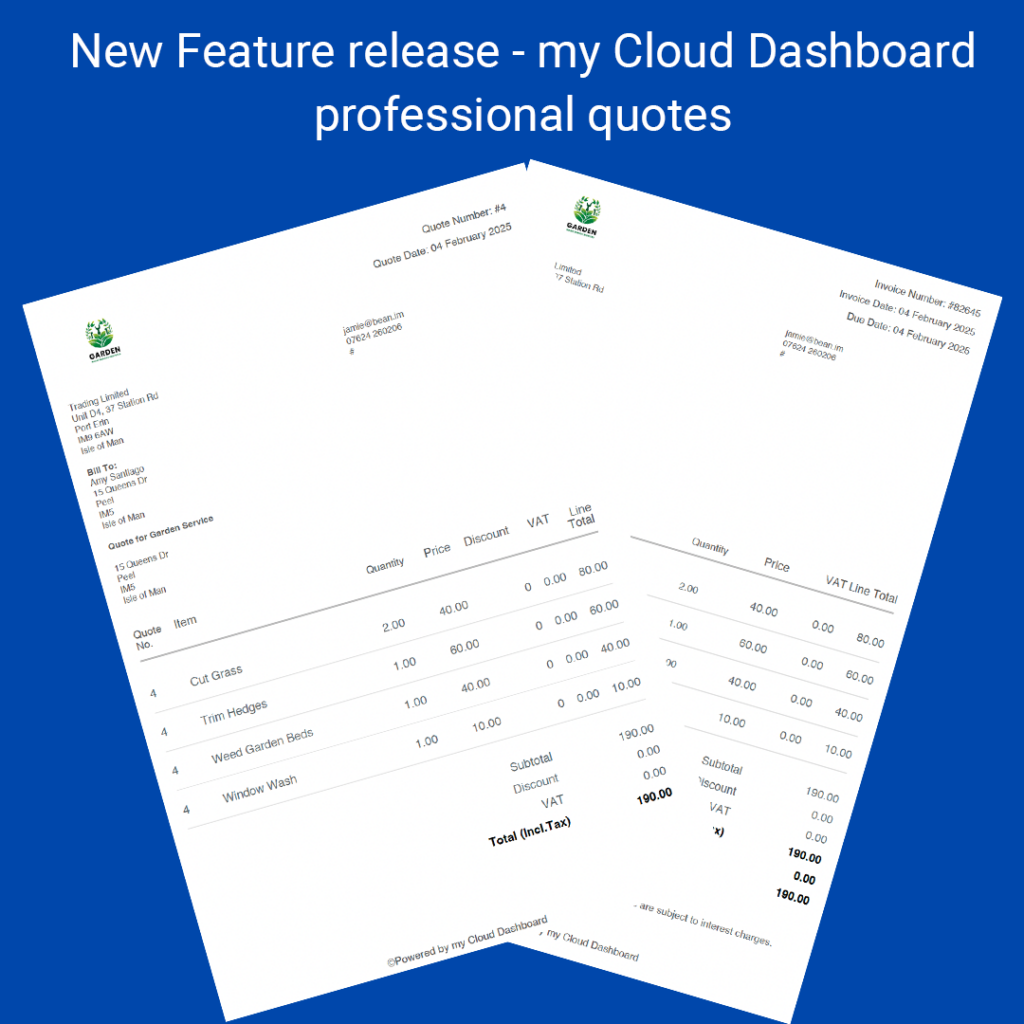
My Cloud Dashboard Introduces New Quote Management Feature my Cloud Dashboard, a leading Field Service Management platform, is excited to announce the launch of its new Quote Management feature. This enhancement makes it easier for businesses to create, manage, and convert quotes into orders seamlessly. Key Benefits:Fast & Simple Quote Creation – Easily generate professional quotes in just a few clicks.Seamless Quote-to-Order Conversion – Turn approved quotes into orders without manual re-entry.Automated Customer Approvals – Customers can review and accept quotes online with a single click.Appointment Scheduling – Schedule services directly from a quote.Status Tracking & Notifications – Keep track of quotes and receive real-time updates. “This new feature simplifies the sales process, allowing businesses to streamline their workflow and enhance customer interactions,” said Harrison Bean, Founder at my Cloud Dashboard. The Quote Management feature is now available for all users. For more information, visit www.myclouddash.com or contact [email protected]. About my Cloud Dashboard: My Cloud Dashboard is a powerful SaaS platform designed to help field service businesses who provide an onsite service manage orders, scheduling, and customer interactions efficiently. For media inquiries, contact: Harrison Bean – [email protected] +44 7624 260206
Hidden cost of inefficiency

The Hidden Costs of Inefficiency in Field Service Management When managing a field service business, inefficiency often hides in plain sight. On the surface, things might appear to be running smoothly, but dig deeper, and you’ll find costly bottlenecks eating away at your time, resources, and profits. In this blog post, we’ll uncover the hidden costs of inefficiency and explore how optimizing your processes can significantly boost your bottom line. 1. Wasted Time in Manual Scheduling Manual scheduling is one of the biggest culprits of inefficiency. Assigning jobs by hand can lead to overlapping appointments, unbalanced workloads, and frequent rescheduling due to unforeseen issues. These disruptions add up quickly: Time Lost: On average, businesses spend 10+ hours per week managing schedules manually. Impact: Missed or delayed appointments frustrate customers and erode trust. Solution: Automating your scheduling process ensures optimal job assignments, eliminates overlaps, and adjusts dynamically to changes in real time. 2. Inefficient Communication and Coordination Field service teams rely on clear communication to perform efficiently. However, many businesses still depend on outdated methods like phone calls, emails, or even paper notes. This lack of streamlined communication results in: Delays: Miscommunications between dispatchers, technicians, and customers. Errors: Missed updates or incorrect information reaching the field team. Solution: Real-time updates through a centralized platform keep everyone aligned and minimize misunderstandings. 3. Excessive Travel and Fuel Costs Routing inefficiencies are another hidden drain on resources. Sending technicians on unnecessarily long or poorly planned routes increases travel time, fuel consumption, and vehicle wear and tear: Financial Cost: Fuel expenses and vehicle maintenance can skyrocket with inefficient routing. Environmental Impact: Excessive travel contributes to your company’s carbon footprint. Solution: Route optimization tools can reduce travel time by up to 25%, saving money and improving efficiency. 4. Missed Revenue Opportunities When inefficiencies dominate your workflow, valuable opportunities slip through the cracks. These include: Upselling or Cross-Selling Opportunities: Technicians don’t have the time or information to recommend additional services. Customer Retention: Poor experiences lead to churn, costing you long-term revenue. Solution: Equipping your team with the right tools and information empowers them to provide better service, improving both customer satisfaction and revenue potential. 5. Poor Data Management Without centralized data, decision-making becomes guesswork. Scattered spreadsheets, outdated records, and incomplete reports hinder your ability to: Track performance metrics. Identify trends and areas for improvement. Make informed decisions quickly. Solution: A unified field service management platform consolidates all your data into one place, making it easier to analyze and act on insights. 6. Declining Employee Productivity Frustration from inefficient processes doesn’t just impact the bottom line—it affects your team’s morale. When employees are bogged down by repetitive tasks or disorganized workflows, their productivity and job satisfaction plummet. This can lead to: Higher Turnover Rates: Replacing employees is costly and time-consuming. Lower Output: Teams struggle to meet deadlines and deliver quality work. Solution: Automating repetitive tasks and simplifying workflows enables your team to focus on higher-value activities. The Bottom Line The hidden costs of inefficiency in field service management extend beyond dollars and cents. They erode customer trust, harm team morale, and limit your business’s growth potential. Addressing these inefficiencies can deliver significant ROI, including reduced costs, happier customers, and a more engaged workforce. Ready to Take the Next Step? My Cloud Dashboard is designed to eliminate inefficiencies and streamline your operations. From automated scheduling to real-time updates and data-driven insights, we empower you to optimize every aspect of your field service business. 👉 Book a Demo Today to see how we can help you save time, reduce costs, and grow your business. Efficiency isn’t just about doing things faster—it’s about doing them smarter. Don’t let hidden costs hold your business back. Take control today!
Boosting Productivity with Automated Workflows

Boosting Productivity with Automated Workflows Managing repetitive tasks is not only time-consuming but also prone to human error. Automated workflows can revolutionize the way your business operates. Simplify Repetitive Tasks Tasks like sending welcome emails, confirming orders, or following up on payments can be automated. My Cloud Dashboard’s configurable workflows handle these processes seamlessly Ensure Consistency Automation ensures that every customer receives the same high-quality experience, from onboarding to post-service communication. Reduce Stress Late payments? The system can trigger reminder emails to customers and notify your team when follow-ups are needed. No more worrying about missed tasks or overlooked invoices. Automated workflows let you focus on growing your business instead of getting bogged down by routine tasks.
How Automation Can Save Small Businesses Time and Money
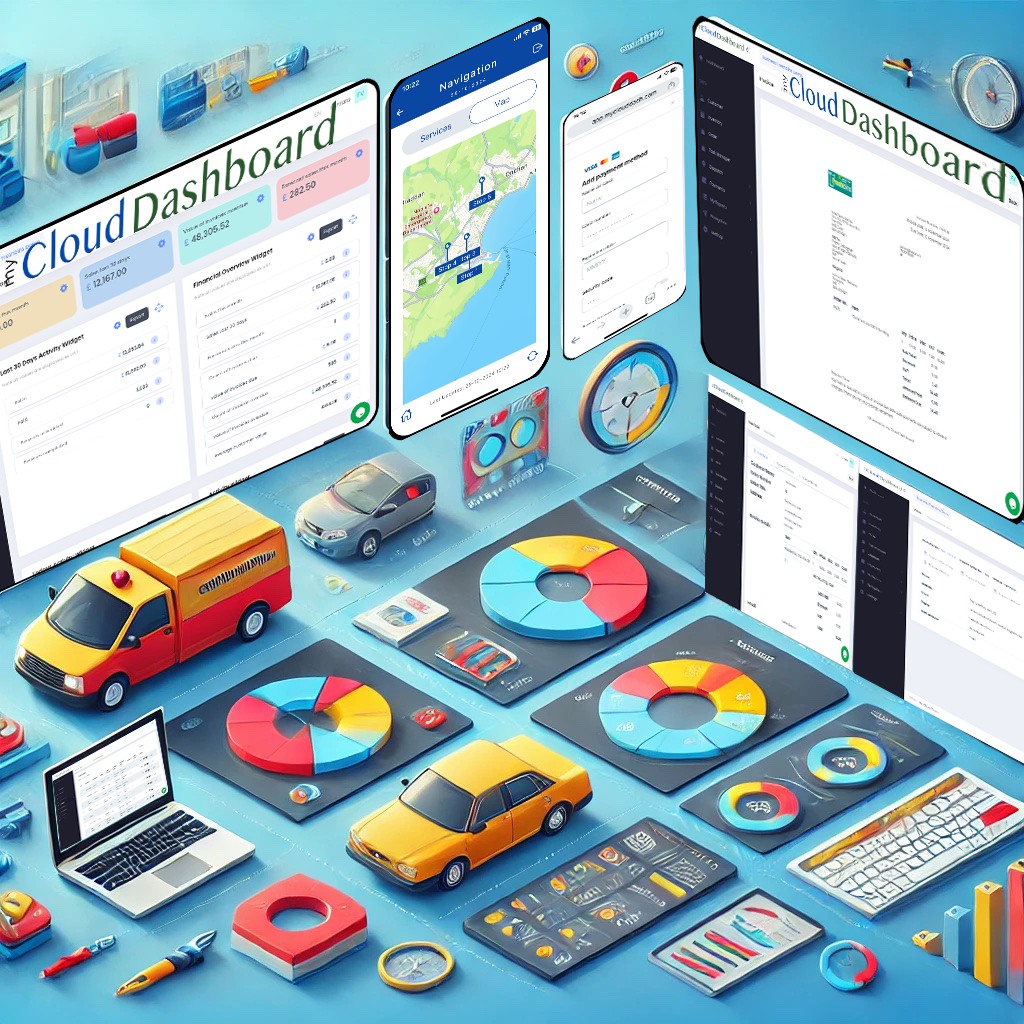
Automation Transforming Small Business How Automation Can Save Small Businesses Time and Money Time is money—especially for small business owners. But repetitive tasks like invoicing, scheduling, and payment follow-ups often dominate the workday. Here’s how automation can free up your time and save you money. Streamline Administrative Tasks Tasks like generating invoices, sending payment reminders, and scheduling services don’t have to be manual. Automating these processes reduces human error, improves efficiency, and allows you to focus on growing your business. Optimize Scheduling With My Cloud Dashboard, you can create recurring schedules for regular customers. This means you’ll never miss a service date, and geographic optimization ensures you’re spending less time and money on travel. Improve Customer Communication Consistent communication builds trust. Automating texts and emails for order confirmations, reminders, and post-service updates keeps customers informed and satisfied. Enhance Cash Flow Management Late payments can disrupt your business. Automation ensures timely reminders are sent to customers and alerts your team when follow-ups are needed. Investing in automation not only reduces costs but also empowers you to achieve more with the same resources. With My Cloud Dashboard, small businesses can operate smarter, not harder.
Smart Scheduling for Small Businesses: Save Time and Money
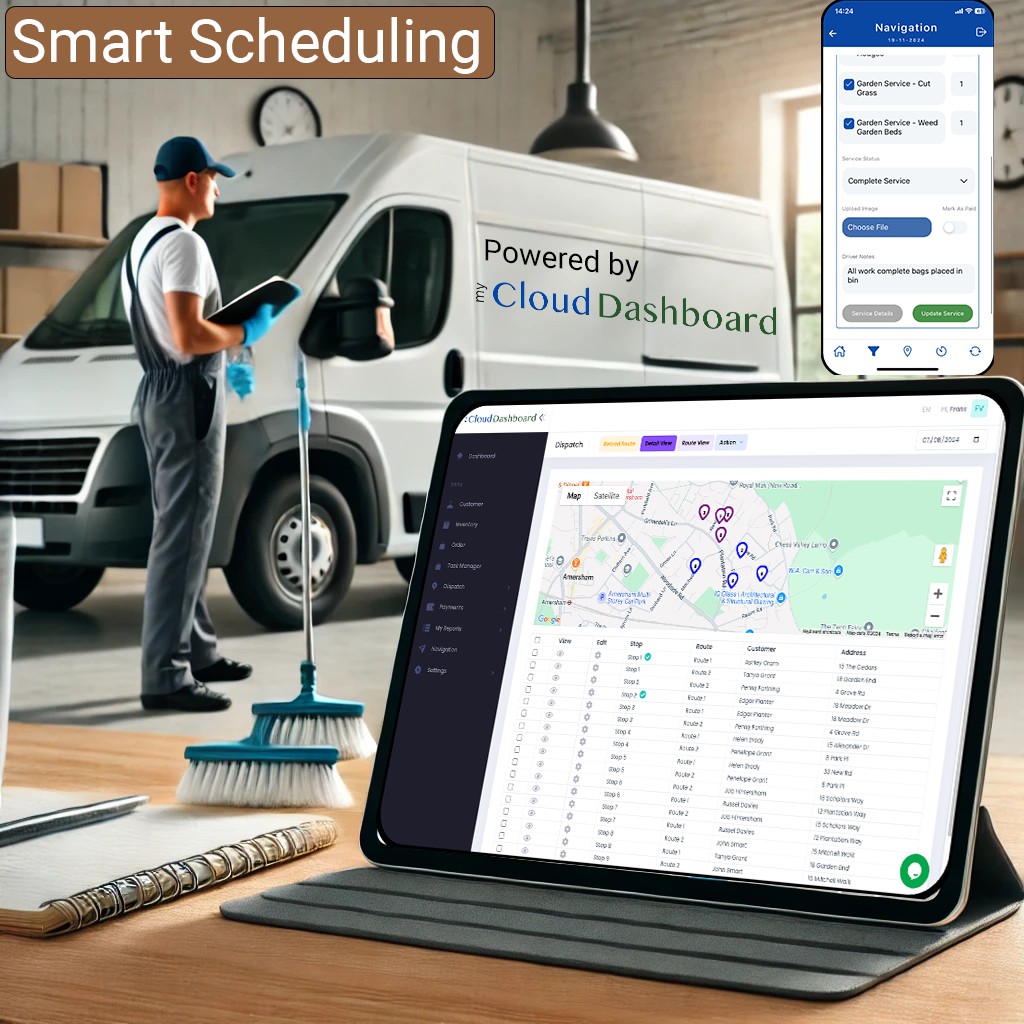
Smart Scheduling for Small Businesses Smart Scheduling for Small Businesses: Save Time and Money Effective scheduling is the backbone of a successful onsite services business. Without a proper system, time and resources are wasted, and customers are left unsatisfied. Here’s how smart scheduling through My Cloud Dashboard can transform your operations. Geographic Optimization Scheduling customers in the same area on the same day reduces travel time and fuel costs. My Cloud Dashboard ensures services are scheduled efficiently, allowing you to cover more ground with fewer resources. Recurring Service Management Manually tracking recurring services can be a logistical nightmare. With My Cloud Dashboard, recurring service dates are automatically generated, eliminating the need for constant manual input. Reduced Errors Smart scheduling minimizes double bookings and scheduling conflicts, ensuring your team operates at peak efficiency. By adopting My Cloud Dashboard’s intelligent scheduling features, you can save valuable time, reduce expenses, and provide a smoother experience for your customers.
Mastering Customer Relationship Management for Onsite Services
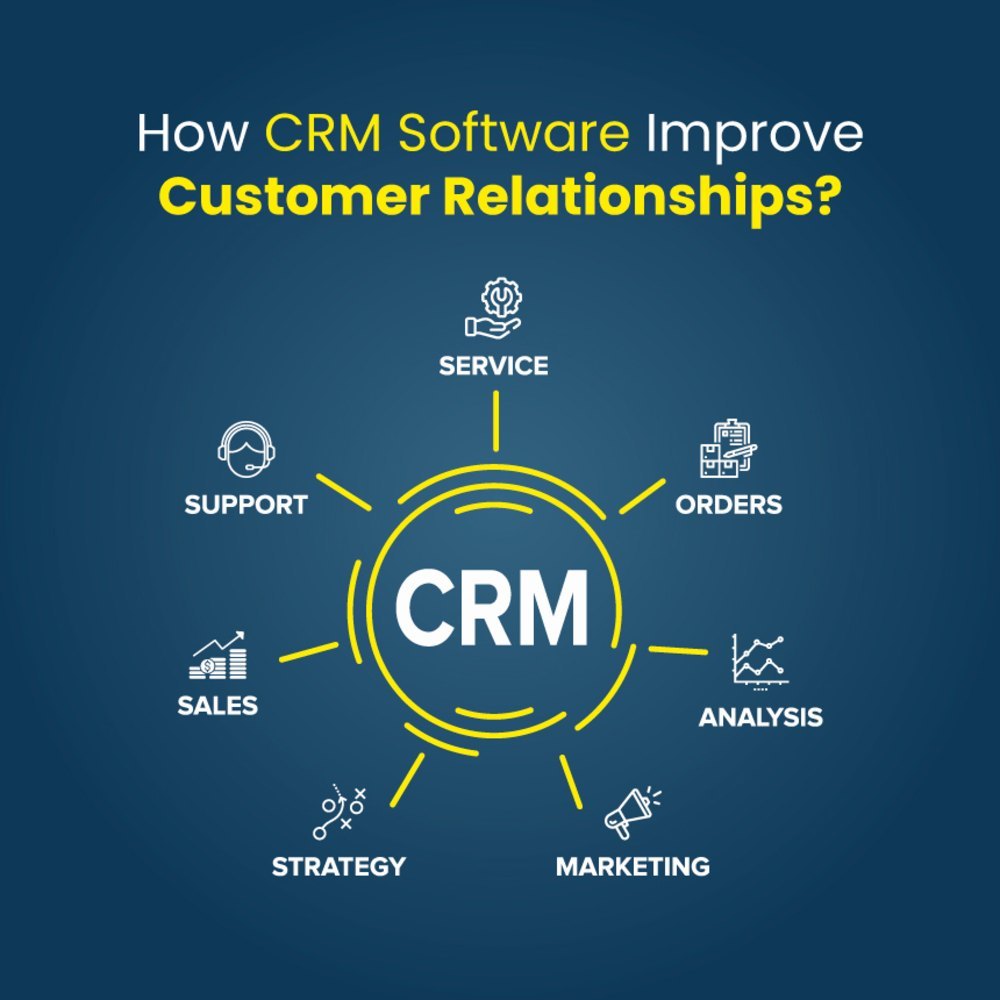
Mastering Customer Relationship Mastering Customer Relationship Management for Onsite Services For small businesses providing onsite services, managing customer relationships is key to success. A well-organized Customer Relationship Management (CRM) system is no longer a luxury—it’s a necessity. Streamlined Customer Onboarding Onboarding new customers should be seamless. my Cloud Dashboard’s flexible CRM enables you to capture customer details quickly and efficiently. With all information in one place, you’re always prepared to meet their needs. Automated Communication Timely communication improves customer satisfaction. From welcome emails to order confirmations and service reminders, my Cloud Dashboard automates touch points throughout the customer lifecycle. Order and Service History at a Glance Knowing your customer’s history is crucial for personalized service. The CRM organizes customer orders and services, providing a comprehensive view of past interactions. Build Lasting Relationships Strong customer relationships lead to repeat business and referrals. my Cloud Dashboard simplifies communication, scheduling, and follow-ups, enabling you to focus on creating meaningful connections. By using a powerful CRM like my Cloud Dashboard, you can improve operational efficiency and deliver exceptional service that keeps customers coming back.
The Top Challenges for Small Business Owners and How to Overcome Them

The Top Challenges for Small Business Owners and How to Overcome Them Running a small business, especially one that provides onsite services, comes with unique challenges. From juggling administrative tasks to managing customer expectations, business owners often feel stretched thin. Let’s explore the top challenges and how My Cloud Dashboard can help overcome them. Challenge 1: Administrative Overload Many small business owners find themselves buried in paperwork—managing invoices, scheduling services, and tracking payments. This eats into time that could be spent growing the business. Solution: Automating administrative tasks through My Cloud Dashboard can save up to 50% of admin time. Features like automated invoicing, payment reminders, and workflow management let you focus on what matters most: your customers. Challenge 2: Scheduling Confusion Efficient scheduling is critical but challenging, especially when services are spread across different geographic locations. Solution: The platform’s smart scheduling system organizes customer service dates and optimizes routes to save time and reduce fuel costs. Predefined schedules ensure recurring services are handled automatically. Challenge 3: Late Payments Chasing payments is frustrating and time-consuming, impacting cash flow. Solution: With My Cloud Dashboard, you can automate payment reminders and overdue notifications. The system alerts you to unpaid invoices, so nothing slips through the cracks. By tackling these common issues, My Cloud Dashboard empowers small business owners to run their operations smoothly and profitably.
